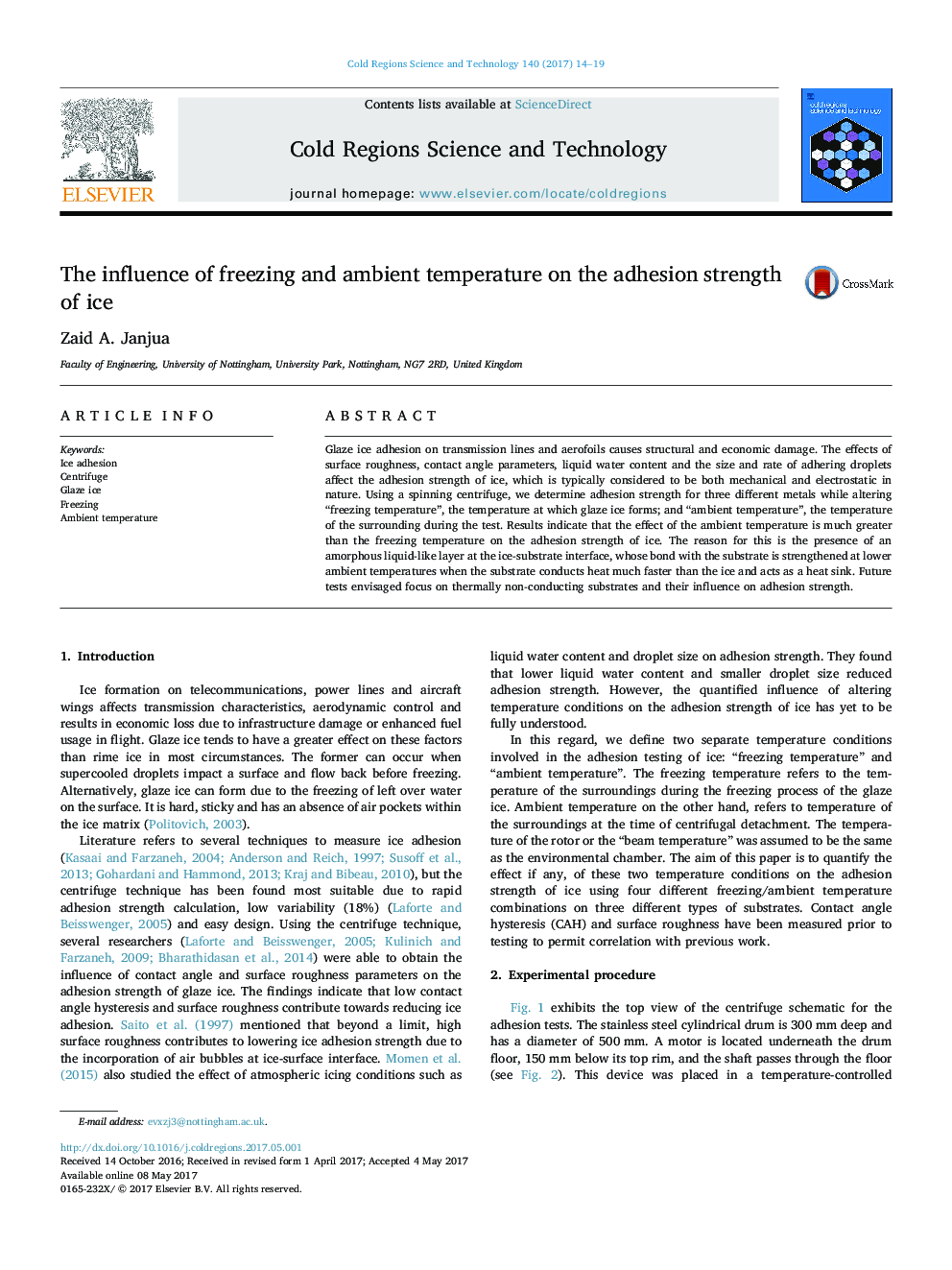| کد مقاله | کد نشریه | سال انتشار | مقاله انگلیسی | نسخه تمام متن |
|---|---|---|---|---|
| 5779396 | 1634424 | 2017 | 6 صفحه PDF | دانلود رایگان |
عنوان انگلیسی مقاله ISI
The influence of freezing and ambient temperature on the adhesion strength of ice
ترجمه فارسی عنوان
تاثیر انجماد و دمای محیط بر مقاومت چسبندگی یخ
دانلود مقاله + سفارش ترجمه
دانلود مقاله ISI انگلیسی
رایگان برای ایرانیان
کلمات کلیدی
چسبندگی یخ، سانتریفیوژ، یخ قوری انجماد دمای محیط،
ترجمه چکیده
چسبندگی یخ قهوه در خطوط انتقال و هوافیل باعث آسیب ساختاری و اقتصادی می شود. اثرات زبری سطح، پارامترهای زاویه تماس، محتوای مایع آب و اندازه و سرعت قطرات جاذب بر قدرت چسبندگی یخ تاثیر می گذارد که معمولا به عنوان ماهیت مکانیکی و الکترواستاتیک در نظر گرفته می شود. با استفاده از یک سانتریفیوژ چرخشی، مقاومت به چسبندگی را برای سه فلز مختلف در حالی که تغییر دمای دمای یخ زدگی را تعیین می کنیم، تعیین می کنیم؛ درجه حرارت یخ زدگی آن؛ و درجه حرارت محیط، دما اطراف در طول آزمون. نتایج نشان می دهد که اثر دمای محیط بسیار بالاتر از دمای یخ زدگی بر مقاومت چسبندگی یخ است. دلیل این امر، حضور یک لایه مایع غیر مورفیک در رابط یخ بستر است که پیوند آن با بستر در دماهای پایین تر تقویت می شود، زمانی که بستر حرارت را بسیار سریعتر از یخ هدایت می کند و به عنوان یک گرمایش گرما عمل می کند. تست های آینده بر روی بستر های گرما غیر هدایت شده و تاثیر آن بر قدرت چسبندگی تمرکز می کنند.
موضوعات مرتبط
مهندسی و علوم پایه
علوم زمین و سیارات
علوم زمین و سیاره ای (عمومی)
چکیده انگلیسی
Glaze ice adhesion on transmission lines and aerofoils causes structural and economic damage. The effects of surface roughness, contact angle parameters, liquid water content and the size and rate of adhering droplets affect the adhesion strength of ice, which is typically considered to be both mechanical and electrostatic in nature. Using a spinning centrifuge, we determine adhesion strength for three different metals while altering “freezing temperature”, the temperature at which glaze ice forms; and “ambient temperature”, the temperature of the surrounding during the test. Results indicate that the effect of the ambient temperature is much greater than the freezing temperature on the adhesion strength of ice. The reason for this is the presence of an amorphous liquid-like layer at the ice-substrate interface, whose bond with the substrate is strengthened at lower ambient temperatures when the substrate conducts heat much faster than the ice and acts as a heat sink. Future tests envisaged focus on thermally non-conducting substrates and their influence on adhesion strength.
ناشر
Database: Elsevier - ScienceDirect (ساینس دایرکت)
Journal: Cold Regions Science and Technology - Volume 140, August 2017, Pages 14-19
Journal: Cold Regions Science and Technology - Volume 140, August 2017, Pages 14-19
نویسندگان
Zaid A. Janjua,
